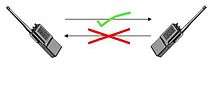Simplex communication

Simplex communication is a communication channel that sends information in one direction only.[1] The International Telecommunication Union definition is a communications channel that operates in one direction at a time, but that may be reversible; this is termed half duplex in other contexts. A duplex communication channel requires two simplex channels operating in opposite directions.
For example, in TV and radio broadcasting, information flows only from the transmitter site to multiple receivers. A pair of walkie-talkie two-way radios provide a simplex circuit in the ITU sense; only one party at a time can talk, while the other listens until it can hear an opportunity to transmit. The transmission medium (the radio signal over the air) can carry information in only one direction.
The old Western Union company used the term simplex when describing the half-duplex and simplex capacity of their new transatlantic telegraph cable completed between Newfoundland and the Azores in 1928.[2] The same definition for a simplex radio channel was used by the National Fire Protection Association in 2002.[3]
Examples
- Commercial radio and television broadcast (not two-way radio such as walkie-talkies)
- Garage door openers
- Baby monitors
- Wireless microphones
- Radio controlled models
- Public address systems
- Surveillance cameras
- Pagers
- Communication between a mouse and a computer
- Internet multicast
- Radio navigation beacons and radiolocation services such as GPS
- Telemetry
- printers
References
- ↑ IEEE Std. 100 "Dictionary of Standards Terms", "Simplex" p.1053
- ↑ Milnor, J.W. and G.A. Randall. "The Newfoundland-Azores High-Speed Duplex Cable". A.I.E.E. Electrical Engineering. May 1931
- ↑ Report of the Committee on Public Emergency Service Communication. NFPA 1221, May, 2002.